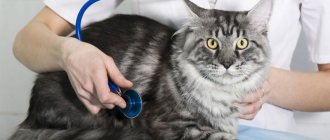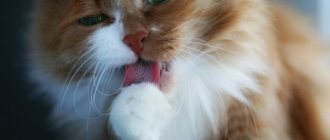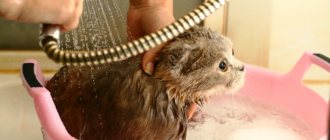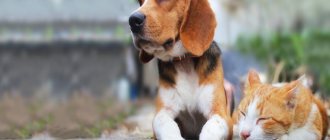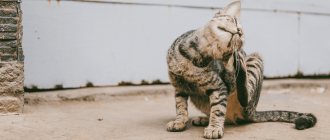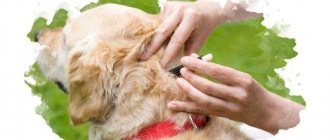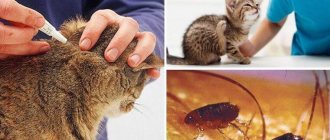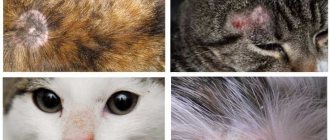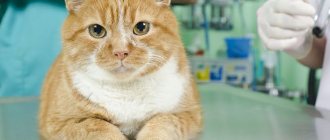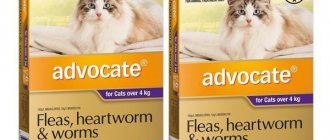The substances contained in drops for fleas in cats are not intended for internal use. Incorrect application or excessive cleanliness of the pet often leads to the medicine getting inside. The result of this is often poisoning.
The severity of symptoms depends on many factors. More details on how to act in such situations and help the cat as quickly as possible will be discussed below.
Is poisoning from flea drops dangerous?
The insecticides that form the basis of the drugs in this line are contained in the minimum required concentrations. They contain just enough active substances to kill insects without causing harm to the animal. Even a significant amount of licked flea drops will not cause death, but there is a danger of poisoning.
Even a veterinarian will not give a definite answer to what will happen if a cat licks flea drops. The determining factors are:
- combination of active ingredients and their concentration in the medicine;
- the number of drops that got inside (usually, if they accidentally hit the oral mucosa, they cause bitterness in the animal, prompting the animal to refuse further licking from the treated area of fur);
- cat immunity;
- age and weight of the animal.
Drops on the withers
Flea repellent poisoning may have no symptoms in a healthy adult cat. However, old, recently severely ill and fragile young animals will feel seriously unwell from the medicine. Symptoms can last from a couple of hours to several days.
Reviews and comments
+2 Galina 09/12/2015 18:19 My cat, after I applied flea drops behind his ears and on the top of his head, went crazy: he started licking his paw, rubbing it on his head and licking it. I tried to distract him by scratching behind his ear, but he again rubbed his head and licked his paw. I don’t know, maybe the drops stung the skin? But nothing bad happened to Leopard: there was no lethargy or diarrhea.
Quote
0 Alexander 06/05/2016 15:10 I accidentally mixed up the drops. I treated the cat with Advantix 4.0! There is no way to get to the veterinarian. It’s the 3rd day. The cat is shaking, his head and front paws! No diarrhea!!! How can I help him???
Quote
0 Marie 03/23/2017 18:05 I quote Alexander:
I accidentally mixed up the drops. I treated the cat with Advantix 4.0! There is no way to get to the veterinarian. It’s the 3rd day. The cat is shaking, his head and front paws! No diarrhea!!! How can I help him???
How is he doing? Quote
Safety precautions for application
The manufacturer's recommendations indicate that the composition should be applied to the area between the shoulder blades along the spine. The cat will not be able to turn its head so as to reach the withers area.
Unfortunately, correct application does not provide a 100% guarantee of protection against droplets getting into the animal. To prevent flea treatment from causing poisoning, you should adhere to the following rules:
- do not apply drops in a long line (an area of 2 cm is sufficient);
- try to distribute the medicine closer to the hair roots;
- If there are several cats in the house, isolate them from each other during treatment.
You can try to protect especially resourceful cats by attaching a collar to the neck. It will fix the head and prevent it from reaching the areas treated with insecticide. The time for complete absorption of the drug is about 2 hours (manufacturers indicate the exact period in the annotation). After this, the remaining drops become completely safe.
Ways to combat parasites in kittens of different ages
Every owner wants to free his ward from uninvited guests as efficiently and carefully as possible. There are different ways to control fleas:
- mechanically clean - bathe and remove fleas manually or by combing; You can remove fleas from a kitten by combing
- wash the kitten with antiparasitic shampoo;
- apply other antiparasitic agents;
- choose gentle folk recipes.
In kittens up to 1 month
At the age of up to 1 month, the kitten is not yet ready for potent drugs; its immunity is weak and susceptible to infections and diseases. Therefore, our recommendation would be to postpone the fight against bloodsuckers until the age of 3-4 months, if there are still few fleas. Only if the animal is constantly itching and tearing the skin with its claws can mechanical treatment begin:
- Wash the old bedding and put on a new one.
- Vacuum and wash the area where the kitten lives.
- Comb out parasites with a fine-toothed comb. Parasites on a kitten should be combed out with a fine-toothed comb.
Try to do these manipulations as often as possible - preferably every day. Such procedures will alleviate the kitten’s condition and delay the use of antiparasitic drugs.
In kittens up to two months
If the kitten’s condition is deplorable, and you can’t wait to help your pet, find flea shampoo for kittens up to two months on sale.
You need to wash your kitten with flea shampoo as follows:
Start by trimming your pet's nails, otherwise your hands could get pretty damaged. Check that there are no drafts and that the house is warm. Cats get very cold after bathing. Then prepare the necessary tools: a basin (bath), shampoo, a comb for combing and a towel. Hold the kitten and, gently talking and stroking it, place it in a bowl of warm water (38–42 °C). Begin to calmly and confidently wash the kitten from head to toe. To prevent water from getting into your ears, carefully insert cotton swabs into them, and apply a drop of Vaseline to the teardrops of your eyes with a cotton swab. As soon as the fur is wet, apply the diluted shampoo to the kitten's body and paws, lather thoroughly and hold for 7-8 minutes. To remove fleas, apply shampoo to the kitten's fur and leave for 7-8 minutes. Then rinse the kitten under running water. Please note that rinsing off shampoo is a thorough and mandatory process.
Rinse for 5-7 minutes, otherwise the shampoo may not be washed out, and the animal will be poisoned when licking it from the fur. After washing, you need to properly rinse the shampoo from the kitten’s fur so that the animal does not get poisoned when licking. Immediately after rinsing the shampoo, place the pet in a towel, it will begin to tremble, it is important to wrap and warm the baby. You can start combing out fleas with a comb right in the towel. They are clearly visible in wet wool. Wipe, dry, caress the kitten - it has gone through a lot of stress.
In kittens after 2–3 months
Your pet has grown up, and the arsenal of means to combat bloodsuckers has grown. Now you can use drops on the withers, a collar for prevention, flea sprays or folk recipes for removing parasites from a kitten’s fur.
Signs of poisoning
The cat, by licking drops of fleas, ensures that insecticides enter the gastrointestinal tract. Therefore, the main symptoms of poisoning manifest themselves from this body system. The most common sign that a cat has licked Bars flea drops or another popular brand is excessive salivation, thirst and loss of appetite. Harmless symptoms disappear spontaneously after a couple of days.
Attention! Drops, once on the mucous membrane of the mouth and esophagus, provoke severe dryness. Hence the animal’s desire to drink a lot of water. Thirst plays into your hands in such a situation; it helps to quickly remove toxins from the body.
For poisoning from flea drops to manifest itself in full force, the animal must swallow almost the entire contents of the bottle or have poor immunity. Signs of severe intoxication:
- vomit;
- diarrhea;
- lethargy and passivity;
- greatly dilated pupils;
- trembling and convulsions.
If a cat has licked off flea drops, it may become very unsteady and skid when running or walking. Before jumping, the animal takes a long time to try it on due to disorientation in space.
Vomit
In addition to poisoning, flea drops sometimes cause an allergic reaction. This usually happens when the dosage is violated or an untested brand of the drug is used. Symptoms of intolerance:
- profuse lacrimation;
- local itching and redness of the skin;
- the appearance of bald spots at the site of application of the medicine.
In these cases, the cause of the symptoms has nothing to do with ingestion of the drops. To eliminate them, the applied composition is washed off, and other lines of products are used to treat fleas.
Prevention
To prevent licking, apply drops according to the instructions.
If there are several animals, they are isolated or put on an Elizabethan collar. The insecticide is purchased in specialized stores. You should not use budget options. Advantage, Frontline or Advocate are effective and low-toxic drugs for killing fleas. Water deactivates the insecticidal effect of the drops, so the pet should not be wetted for the first four days.
It is unacceptable for the active component of the anti-flea agent to enter the bloodstream from the digestive tract. If a cat licks a friend treated against insects, it will be poisoned. In order for the contents of the drops to become insoluble, they must be allowed to dry. When there are several animals, they are isolated or an Elizabethan collar is used.
https://zelenplaneta.ru/blohi/chto-delat-esli-kot-slizal-kapli-ot-bloh.htmlhttps://notklop.ru/blohi/blohi-u-koshek/koshka-slizala-kapli-ot- bloh/https://apest.ru/blohi/blohi-u-koshek/koshka-slizala-kapli-ot-bloh/https://parazitdoma.ru/sovety/koshka-slizala-kapli-ot-blohhttps:// localvet.ru/koshki/simptomy/kot-slizal-kapli-ot-bloh
What to do if your cat is poisoned?
When a cat is poisoned by flea drops, the recovery period depends on the measures taken by the owner, who must know what to do first to stop the manifestations of intoxication and how to provide basic treatment. Particular attention is paid to the nutrition of the affected cat.
First aid for an animal
Treatment of a cat poisoned by flea drops begins with sorbent agents. Medicines in this group relieve attacks of nausea, act like a sponge, absorbing insecticides and preventing them from penetrating the blood.
For representatives of the cat family, the medications listed in the table are suitable:
| Name of medicine | Dosage |
| Activated carbon | 1 tablet per 1 kg of cat weight, 3-4 times a day |
| Polysorb | 0.1-0.2 g per 1 kg of body weight |
| Filtrum | 7 g of the drug is diluted in 50 ml of water and given to the pet 2-4 ml per 1 kg of body weight |
| Enterosgel | 1 cm of paste, squeezed onto a spoon |
| Smecta | 1-2 ml of solution per 1 kg of animal weight, 2-5 times a day |
They bind and remove toxins, as a result of which digestion is normalized, intestinal motility and kidney function are improved.
The second most common symptom that occurs if a cat licks flea drops is diarrhea. Smecta will handle its elimination. Additionally, rice or chamomile infusion is given. It is prepared from 1 tbsp. cereals (or dried vegetable collection) and 1.5 tbsp. water. The ingredients are boiled, filtered, cooled and given to your pet to drink.
Treatment of a poisoned cat
Poisoning with flea drops, even with proper and timely treatment, does not go away in a couple of hours. To help your pet, you will have to organize a full-fledged therapeutic course. It is convenient to use a syringe without a needle to administer medications. A healing solution is injected into it, the required amount of which is determined using a measuring scale on the body of the device.
Introduction technique:
- hold the cat motionless;
- throw back the animal's head;
- press your fingers on both sides into the area between the lower and upper teeth;
- pour the drug solution into the cheek in small portions.
The medicine Drotaverine (NoShpa) or Baralgin will help against flea poisoning accompanied by pain. Taking these medications does not have the best effect on the animal’s digestion. After the therapy, the intestinal microflora will have to be restored. The drug Vetelact will cope well with the task.
Vetelakt
If intoxication caused by poisoning with flea drops does not go away and the cat spits out all the medicine, injections into the thigh area are allowed. However, the veterinarian must give the injections.
Feeding a cat after poisoning
Properly organized nutrition is one of the main conditions that determine how quickly a cat will recover. If a cat is poisoned with flea drops, it is deprived of food for a day. The digestive tract irritated by insecticides must be protected from stress. It is advisable to clean the full stomach by inducing vomiting in the cat. If necessary, do an enema.
Strong thirst after intoxication is a good sign. The more the animal drinks, the sooner the recovery will occur. For weakened cats that refuse fluids, water is forcibly infused at a rate of 5 ml at a time.
When the main symptoms of poisoning pass, the pet is transferred to a diet menu of cereals, chicken broth and fermented milk products. Meat and dry food are banned for a week.
Features of kitten treatment
It becomes more difficult when a kitten is poisoned by flea drops. It receives the same concentration of insecticides, and its body weight is several times less than that of an adult animal. In order not to risk your pet’s health, at the slightest sign of discomfort, it is better to contact a veterinarian.
In general, the technology for treating kittens is the same as for adults. It is supplemented with the following groups of drugs:
- decoctions that give a diuretic effect (lingonberries, bearberry, tansy, St. John's wort are suitable);
- veterinary medications that support the functioning of the liver (Hepatovet, Hepatolux, Gepasafe, Corsil);
- saline and glucose to support animals with severe dehydration.
The standard course of treatment is 30 days, but if necessary, it is adjusted by the veterinarian based on the general condition of the patient and the emerging dynamics.
Visit doctor
After carrying out all the necessary manipulations, you should take the kitten to the nearest clinic. To simplify diagnosis and prescribe therapy, it is recommended:
- At the first symptoms of poisoning in a kitten, you should show it to a veterinarian
if possible, take with you a sample of the suspected poisonous product (a small portion of food or liquid, medication packaging, a sprig of a poisonous plant);
- collect the remaining vomit in a bag or sealed container;
- calculate the approximate amount of poison swallowed;
- remember and describe the stages and rate of development of symptoms, all manifestations of pathology, the presence of concomitant diseases or allergies to medications in the kitten;
- If you suspect intoxication with waste products of helminths, collect a small amount of feces.
The veterinarian will conduct a visual examination of the pet,, if necessary, prescribe laboratory and instrumental examinations and prescribe treatment. In severe cases, detoxification therapy may be required in the form of IVs or injections, as well as surgery.
How to protect an animal from poisoning?
Treating a cat with anti-parasite drops is a responsible undertaking. Although the concentration of chemicals in the drug is considered relatively harmless to the animal, ingestion of the flea agent should be avoided at all costs. Proper application plus compliance with safety precautions is a reliable guarantee of your pet’s health.
For mild infections or for prevention, veterinarians advise using natural essential oils. The scents of tangerine and anise repel fleas. If they are applied to the cat's withers, the parasites will not bother her.
Contraindications
There are also contraindications for using Inspector on cats. In the first place is the identified individual intolerance or increased sensitivity of the pet to the substances of the solution.
Kittens that are not yet seven weeks old should not be treated either. Inspector is not contraindicated for a kitten older than this age.
The use of the drug on animals suffering from infectious diseases and those in the recovery stage is prohibited. It is also better not to disturb a cat that has recently given birth.
If a medicine with macrocyclic lactones is used in parallel, then taking the Inspector is prohibited.
It is prohibited to use the drug to treat ear mites if a perforation of the eardrum is detected.
Infectious skin diseases
Ringworm is a skin disease accompanied by:
- the formation of a small rash;
- damage to fur and claws.
This disease can occur due to a viral infection or reduced immunity of the animal.
There are the following factors that contribute to the development of lichen in pets living at home:
- walking outside without supervision;
- treatment with immunosuppressants;
- malnutrition;
- parasite infection;
- malignant formations.
The most common causes of ringworm in cats are those caused by fungal infections. There are several types of lichen:
- Ringworm, which is based on fungal diseases. This type is easily transmitted to humans, especially to young children. Fungal spores remain viable for 5-10 years because they are resistant to environmental influences.
- Versicolor or pityriasis versicolor, which is a dangerous disease. The cause of its occurrence is a yeast-like fungus, which under certain conditions transforms into a pathogenic form.
- A shingles or pink appearance that appears when immunity is reduced and is of an allergic nature.
- Eczema or tinea versicolor manifests itself in animals as an allergic reaction to a specific irritant and is not transmitted through contact with humans or other animals. Allergies can be caused by exposure to household chemicals, a malfunction within the body, or stress.
All types of lichen in cats have common symptoms:
- hair loss;
- inflammation of the skin accompanied by peeling;
- change in pigmentation;
- severe scabies.
If you suspect lichen, the cat should be isolated immediately. A glazed balcony, loggia or separate room is suitable for this; you need to make sure that the room is warm. After this, you need to contact a veterinarian to establish through diagnostics the cause of the cat’s itching and methods of treating it.
To prevent such diseases from occurring in cats, it is recommended to periodically vaccinate them for preventive purposes.
Skin diseases are the most common problems causing problems for cats and their owners. Most often, this affects pets that occasionally walk outside.
Diseases caused by bacterial infections occur in two forms, such as:
- dry, accompanied by the formation of dry scaly plates and crusts;
- wet, expressed in the appearance of ulcers and blisters filled with exudate.
Cats with hypersensitive skin are at risk of developing eczema. The reasons for its occurrence may be different:
- skin damage due to prolonged friction from contact with any object (collars, harnesses, etc.), due to burns and parasite bites;
- consequences of internal disorders in the body (neuropathy): hormonal imbalance, diabetes.
With eczema, the animal's skin develops rashes and blisters. There is a constant itching sensation in the affected areas (including the neck). To treat this disease, various ointments, soothing powders, and antibiotics are used.
A common disease among cats is acne (blackheads). Its cause may be the animal's low immunity, being under stress or improper care. This bacterial infection has a detrimental effect on the sebaceous glands. As a rule, its presence is indicated by rashes in the form of ulcers throughout the animal’s body. The largest accumulation of acne occurs on the cat's chin, neck and lip area.
At the beginning of treatment, the skin is first treated with antiseptic detergents.
